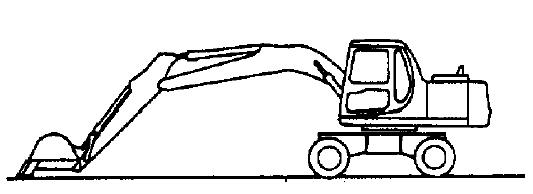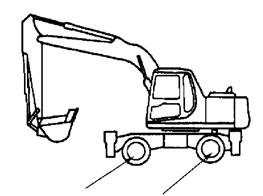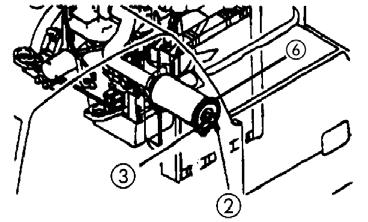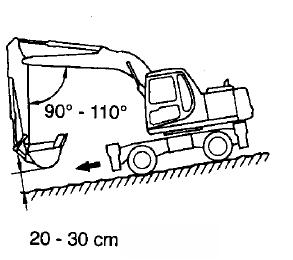
7 minute read
OUTLINES OF SERVICE
Use Komatsu genuine parts for replacement.
When changing or adding oil, do not use a different type of oil.
Unless otherwise specified, the oil and coolant used at the time of shipment from the factory are as shown in the table below.
Item Kind of fluid
Engine oil pan
Swing machinery case PTO gear case
Hydraulic tank
Fuel tank
Radiator SAE 15W-40 API classification CE
SAE 30 API classification CD
SAE 10 W PI classification CD
ASTM D975 No.2(However, ASTM D975 No.1 is used for the winter season (October to March)
Komatsu Super Coolant (AF-ACL) 41% added to water
Axles, Hubs SAE 80W-90 API GL4 (MULTI-OIL)
Transmission SAE 20W-30 API GL4
OUTLINE OF OIL, FUEL, COOLANT
OIL
Oil is used in the engine and work equipment under extreme severe conditions (high temperature, high pressure), and it deteriorates with use. Always use oil that matches the grade and temperature for use given in the Operation and Maintenance Manual. Even if the oil is not dirty, always replace the oil after the specified interval.
Oil corresponds to blood in the human body, so always be careful when handling it to prevent any impurities (water, metal particles, dirt, etc.) from getting in. The majority of problems with machine are caused by the entry of such impurities. Take particular care not to let any impurities get in when storing or adding oil.
Never mix oils of different grades or brands.
Always add the specified amount of oil. Having too much oil or too little oil are both causes of problems.
If the oil in the work equipment is not clear, there is probably water or air getting into the circuit. In such cases, please contact your Komatsu distributor.
When changing the oil, always replace the related filters at the same time.
We recommend you to have an analysis made of the oil periodically to check the condition of the machine. For those who wish to use this service, please contact your Komatsu distributor.
FUEL
The fuel pump is a precision instrument, and if fuel containing water or dirt is used, it cannot work properly.
Be extremely careful not to let impurities get in when storing or adding fuel.
Always use the fuel specified in the Operation and Maintenance Manual.
Fuel may congeal depending on the temperature when it is used (Particularly in low temperature below-15°C), so it is necessary to change to a fuel that matches the temperature.
To prevent the moisture in the air from condensing and forming water inside the fuel tank, always fill the fuel tank after completing the day’s work.
Before starting the engine, or when 10 minutes have passed after adding fuel, drain the sediment and water from the fuel tank.
If the engine runs out of fuel, or if the filters have been replaced, it is necessary to bleed the air from the circuit.
COOLANT
River water contains large amounts of calcium and other impurities, so if it is used, scale will stick to the engine and radiator, and this will cause defective heat exchange and overheating. Do not use water that is not suitable for drinking.
When using anti-freeze, always observe the precautions given in the Operation and Maintenance Manual.
Komatsu machines are supplied with Komatsu original antifreeze in the coolant when the machine is shipped. This anti-freeze is effective in preventing corrosion of the cooling system. The anti-freeze can be used continuously for two years or 4000 hours. Therefore, it can be used as it is even in hot areas.
Anti-freeze is inflammable, so be extremely careful not to expose it to flame or fire.
The proportion of anti-freeze to water differs according to the ambient temperature.
For details of the mixing proportions, see “CLEAN INSIDE OF COOLING SYSTEM” on page 193.
If the engine overheats, wait for the engine to cool before adding coolant.
If the coolant level is low, it will cause overheating and will also cause problems with corrosion from the air in the coolant.
GREASE
Grease is used to prevent twisting and noise at the joints.
The nipples not included in the maintenance section are nipples for overhaul, so they do not need grease. If any part becomes stiff after being used for long time, add grease.
Always wipe off all of the old grease that is pushed out when greasing. Be particularly careful to wipe off the old grease in places. Where sand or dirt sticking in the grease would cause wear of the rotating parts.
STORING OIL AND FUEL
Keep indoors to prevent any water, dirt, or other impurities from getting in.
When keeping drum cans for a long period, put the drum on its side so that the filler port of the drum can is at the side. (To prevent moisture from being sucked in) If drum cans have to be stored outside, cover them with a waterproof sheet or take other measures to protect them.
To prevent any change in quality during long-term storage, be sure to use in the order of first in first out (use the oldest oil or fuel first).
FILTERS
Filters are extremely important safety parts. They prevent impurities in the fuel and air circuits from entering important equipment and causing problems. Replace all filters periodically. For details, see the Operation and Maintenance Manual. However, when working in severe conditions, it is necessary to consider replacing the filters at shorter intervals according to the oil and fuel (sulphur content) being used.
Never try to clean the filters (cartridge type) and use them again. Always replace with new filters.
When replacing oil filters, check if any metal particles are stuck to the old filter. If any metal particles are found, please contact your Komatsu distributor.
Do not open packs of spare filters until just before they are to be used.
Always use Komatsu genuine filters.
OUTLINE OF ELECTRIC SYSTEM
If the wiring gets wet or the insulation is damaged, the electric system leaks and this could result in hazardous malfunction of the machine.
Services relating to the electric system are (1) check of fan belt tension, (2) check of damage or wear in the fan belt and (3) check of battery fluid level.
Never remove or disassemble any electric components installed in the machine.
Never install any electric components other than these specified by Komatsu.
Be careful to keep the electric system free of water when washing the machine or when it rains.
Since the controller for the control system may cause malfunction due to external wave interference, before installing a radio receiver and a walkie-talkie or citizen band, consult your Komatsu distributor.
When working on the seashore, carefully clean the electric system to prevent corrosion.
When installing a car cooler or an other electrical equipment, connect it to an independent power source connector. The optional power source must never be connected to the fuse, starting switch, or battery relay.
OUTLINE OF HYDRAULIC SYSTEM
During operation and immediately after operation is ended, the temperature of the hydraulic system still re-mains high. In addition, high hydraulic pressure is applied to the system. Take care when inspecting and maintaining the hydraulic system.
Stop the machine on level ground, lower the bucket to the ground, then set so that there is no pressure applied to the cylinder circuit.
Always stop the engine.
Immediately after operations, the hydraulic oil and lubricating oil are at high temperature and high pressure, so wait for the oil temperature to go down before starting maintenance. Even when the temperature goes down, the circuit may still be under internal pressure, so when loosening the plug or screw, or the hose joint, do not stand in front of the part. Loosen it slowly to release the internal pressure before removing it.
When carrying out inspection or maintenance of the hydraulic circuit, always bleed the air from the hydraulic tank to remove the internal pressure.
Periodic maintenance includes the inspection of the hydraulic oil level, replacement of the filter and refilling of hydraulic oil.
When the high pressure hose, etc. is removed, check the Oring for damage. If necessary, replace it.
After the hydraulic filter element and strainer are cleaned or replaced, or after the hydraulic system is repaired or replaced or the hydraulic piping is removed, bleed air from the hydraulic circuit.
The accumulators are charged with high-pressure nitrogen gas. Incorrect handling may be dangerous.






